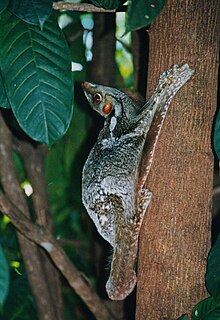|
巽他鼯猴
巽他鼯猴(學名:Galeopterus variegatus)又稱马来亚鼯猴、馬來亞飛狐猴,是鼯猴科斑鼯猴屬(Galeopterus)的單型種。本種分布於東南亞,包括緬甸南部、泰國、越南南部、馬來西亞、新加坡與印度尼西亞(爪哇島、婆羅洲、蘇門答臘與峇里島)[1][3][4],並可分為外形相似、僅體型有異的兩大類群,體型較大的類群分布於巽他陸棚與中南半島,體型較小的類群分布於寮國與巽他陸棚的一些小島[3][5],較前者小約20%[6]。除了體型大小差異外,分子證據顯示巽他鼯猴的基因組已發生分化成四大支系:分布於爪哇島的G. v. variegatus、分布於蘇門答臘的G. v. temminckii、分布於婆羅洲的G. v. borneanus與分布於中南半島的G. v. peninsulae[3],甚至可能被進一步分拆為數個物種[7]。相較於本種分布於東南亞各地,同科的另一現生物種菲律賓鼯猴則僅分布於菲律賓南部[3]。 巽他鼯猴善於爬樹,難以在地面上移動[8];以皮膜滑翔時下降10公尺的高度即可滑行超過100公尺的距離[9]。本種為夜行性,但有時也在白天出沒[10];主要以樹葉為食[11],也有食用昆蟲的紀錄[12];本種目前被IUCN列為無危物種[1],但常為當地人的捕獵對象,且受棲地破壞威脅[13]。 參考文獻
|
||||||||||||||||||||||||||||||||||||||
Index:
pl ar de en es fr it arz nl ja pt ceb sv uk vi war zh ru af ast az bg zh-min-nan bn be ca cs cy da et el eo eu fa gl ko hi hr id he ka la lv lt hu mk ms min no nn ce uz kk ro simple sk sl sr sh fi ta tt th tg azb tr ur zh-yue hy my ace als am an hyw ban bjn map-bms ba be-tarask bcl bpy bar bs br cv nv eml hif fo fy ga gd gu hak ha hsb io ig ilo ia ie os is jv kn ht ku ckb ky mrj lb lij li lmo mai mg ml zh-classical mr xmf mzn cdo mn nap new ne frr oc mhr or as pa pnb ps pms nds crh qu sa sah sco sq scn si sd szl su sw tl shn te bug vec vo wa wuu yi yo diq bat-smg zu lad kbd ang smn ab roa-rup frp arc gn av ay bh bi bo bxr cbk-zam co za dag ary se pdc dv dsb myv ext fur gv gag inh ki glk gan guw xal haw rw kbp pam csb kw km kv koi kg gom ks gcr lo lbe ltg lez nia ln jbo lg mt mi tw mwl mdf mnw nqo fj nah na nds-nl nrm nov om pi pag pap pfl pcd krc kaa ksh rm rue sm sat sc trv stq nso sn cu so srn kab roa-tara tet tpi to chr tum tk tyv udm ug vep fiu-vro vls wo xh zea ty ak bm ch ny ee ff got iu ik kl mad cr pih ami pwn pnt dz rmy rn sg st tn ss ti din chy ts kcg ve






